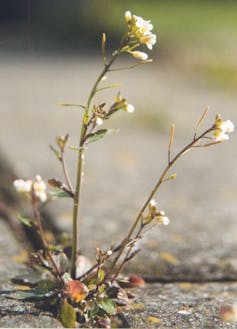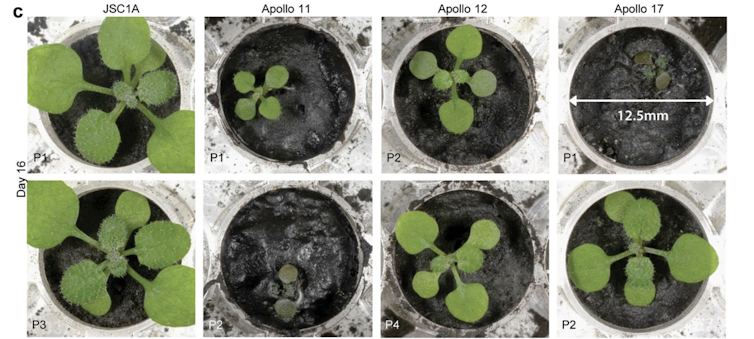How To Grow Plants On The Moon
[ad_1]

Researchers cultivated the plant Arabidopsis thaliana in samples of lunar soil (Representational)
London:
What do you need to have to make your back garden mature? As properly as a lot of sunshine alternating with light showers of rain – and active bees and butterflies to pollinate the vegetation – you require very good, loaded soil to provide important minerals. But imagine you experienced no loaded soil, or showers of rain, or bees and butterflies. And the sunshine was both much too severe and immediate or absent – producing freezing temperatures.
Could crops grow in this kind of an setting – and, if so, which types? This is the issue that colonists on the Moon (and Mars) would have to tackle if (or when) human exploration of our planetary neighbours goes in advance. Now a new study, posted in Communications Biology, has started off to deliver responses.

The scientists behind the examine cultivated the quickly-escalating plant Arabidopsis thaliana in samples of lunar regolith (soil) brought back again from 3 various areas on the Moon by the Apollo astronauts.
Dry and barren soil
This is not the first time that makes an attempt have been produced to develop crops in lunar regolith nevertheless, but it is the first to demonstrate why they never thrive.
The lunar regolith is extremely different from terrestrial soils. For a get started, it won’t have natural and organic subject (worms, germs, decaying plant matter) that is characteristic of soil on Earth. Neither does it have an inherent drinking water written content.
But it is composed of the identical minerals as terrestrial soils, so assuming that the lack of water, sunlight and air is ameliorated by cultivating vegetation inside of a lunar habitat, then the regolith could have the likely to increase crops.
The exploration confirmed that this is in truth the case. Seeds of A. thaliana germinated at the identical charge in Apollo product as they did in the terrestrial soil. But although the vegetation in the terrestrial soil went on to produce root shares and put out leaves, the Apollo seedlings were being stunted and experienced very poor root growth.
The main thrust of the investigation was to take a look at crops at the genetic level. This permitted the scientists to recognise which certain environmental things evoked the strongest genetic responses to anxiety. They located that most of the stress reaction in all the Apollo seedlings arrived from salts, metallic and oxygen that is hugely reactive (the final two of which are not typical in terrestrial soil) in the lunar samples.

The three Apollo samples were being afflicted to distinct extents, with the Apollo 11 samples staying the slowest to improve. Specified that the chemical and mineralogical composition of the three Apollo soils ended up fairly equivalent to each individual other, and to the terrestrial sample, the researchers suspected that vitamins were not the only power at participate in.
The terrestrial soil, termed JSC-1A, was not a common soil. It was a combination of minerals ready exclusively to simulate the lunar floor, and contained no organic issue.
The starting up content was basalt, just as in lunar regolith. The terrestrial version also contained organic volcanic glass as an analogue for the “glassy agglutinates” – small mineral fragments mixed with melted glass – that are ample in lunar regolith.
The scientists recognised the agglutinates as one of the opportunity reasons for absence of advancement by the seedlings in the Apollo soil in comparison to the terrestrial soil, and also for the difference in progress styles among the 3 lunar samples.
Agglutinates are a frequent characteristic of the lunar floor. Ironically, they are shaped by a procedure referred to as “lunar gardening”. This is the way that the regolith changes, by bombardment of the Moon’s surface area by cosmic radiation, photo voltaic wind and minuscule meteorites, also identified as place weathering.
For the reason that there is no environment to sluggish down the very small meteorites hitting the surface area, they affect at high velocity, leading to melting and then quenching (quick cooling) at the effect web page.
Gradually, smaller aggregates of minerals create up, held alongside one another by glass. They also have tiny particles of iron metal (nanophase iron) shaped by the space weathering method.
It is this iron that is the most important change amongst the glassy agglutinates in the Apollo samples and the normal volcanic glass in the terrestrial sample. This was also the most possible cause of the metal-connected anxiety recognised in the plant’s genetic profiles.
So the presence of agglutinates in the lunar substrates triggered the Apollo seedlings to struggle when compared with the seedlings grown in JSC-1A, significantly the Apollo-11 ones. The abundance of agglutinates in a lunar regolith sample relies upon on the duration of time that the product has been uncovered on the surface, which is referred to as the “maturity” of a lunar soil.
Pretty mature soils have been on the surface area for a extensive time. They are observed in sites where by regolith has not been disturbed by a lot more new impression events that produced craters, while immature soils (from down below the surface area) happen all over contemporary craters and on steep crater slopes.
The a few Apollo samples had diverse maturities, with the Apollo 11 material getting the most mature. It contained the most nanophase iron and exhibited the best steel-associated anxiety markers in its genetic profile.
The worth of youthful soil
The review concludes that the additional mature regolith was a significantly less efficient substrate for escalating seedlings than the considerably less mature soil. This is an crucial conclusion, for the reason that it demonstrates that crops could be grown in lunar habitats working with the regolith as a useful resource. But that the spot of the habitat must be guided by the maturity of the soil.
And a past thought: it struck me that the conclusions could also apply to some of the impoverished areas of our planet. I really don’t want to rehearse the old argument of “Why shell out all this cash on room exploration when it could be better expended on faculties and hospitals?”. That would be the subject matter of a unique report.
But are there engineering developments that come up from this investigate that could be applicable on Earth? Could what has been discovered about strain-associated genetic modifications be applied to produce additional drought-resistant crops? Or vegetation that could tolerate greater ranges of metals?
It would be a terrific accomplishment if generating crops improve on the Moon was instrumental in encouraging gardens to develop greener on Earth.![]()
(Creator: Monica Grady, Professor of Planetary and Space Sciences, The Open up University)
Disclosure assertion: Monica Grady is Professor of Planetary and Space Sciences at the Open College. She receives funding from the STFC and the United kingdom Area Agency. She is Chancellor of Liverpool Hope College and a Senior Study Fellow at the All-natural Heritage Museum. Observe her on twitter @MonicaGrady
This short article is republished from The Conversation underneath a Creative Commons license. Browse the authentic report.
(Other than for the headline, this story has not been edited by NDTV staff and is released from a syndicated feed.)
[ad_2]
Supply connection
